Xinjiang: China’s Pre- and Post-Modern Crossroad
Dru Gladney
University of Hawaii, Manoa
n all of China, there are only three public statues left of Chairman Mao. Of the three, the one in Xinjiang is perhaps the most incongruous. It is in Kashgar, the farthest city in China from Beijing, and in a place never visited by the Chairman. With arm upraised, gazing across the People’s Square toward the southern end of the city (and India/Pakistan), Chairman Mao’s statue signals that though it is one of the most remote cities from Beijing, since 1949 it has been firmly under Chinese control. Bordering People’s Square and well within the Chairman’s gaze is the huge new Bank of China building — the newest monument to Chinese rule. Yet, it has not always been so.
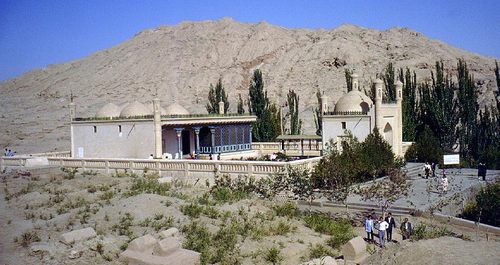
Fig. 1. Mahmud al-Kashgari’s mausoleum at Upar.
Xinjiang remains one of the pivotal crossroads of China and Central Asia, and has only been intermittently under Chinese influence and control during relatively recent times in its 3000-year history. The history of the region is marked by many influences due to its central place between several civilizations. At a natural intersection of pathways leading from the ancient capitals of Rome, Persia, Mongolia, and China, its strategic location at the eastern end of the ancient Silk Road, it continues today as a meeting place of many cultures. Sir Aurel Stein, the 20th century’s greatest Central Asian explorer, characterized the region as a “special meeting ground of Chinese civilization, introduced by trade and political penetration, and of Indian culture, propagated by Buddhism.” Islam contributed Arab, Persian, and later Turkic civilizations to the region. The new “Trans-Eurasia” railroad between Europe and China that passes through Urumqi, completed in 1991, links China as never before with Europe; in addition, there is an increasing number of air and road routes to Kyrgyzstan, Kazakhstan, Tajikistan, Mongolia, Afghanistan, and Pakistan. Bordered by some of the highest mountains in the world, in the north, east, south and south-west by the great Altai, Tianshan, Pamir, and Kunlun mountain ranges, and hemmed in from the west by the Gobi and Taklamakan Deserts, the second largest in the world, Xinjiang is a place with a long and complicated history, located somewhere between mountain and steppe, oasis and desert, East and West. The faces, languages, clothing, and dwellings of the “Eastern Turkestanis” who inhabit the towns and the new “golden hordes” of travelers who pass through are the most enduring legacy of this multicultural and diverse history.
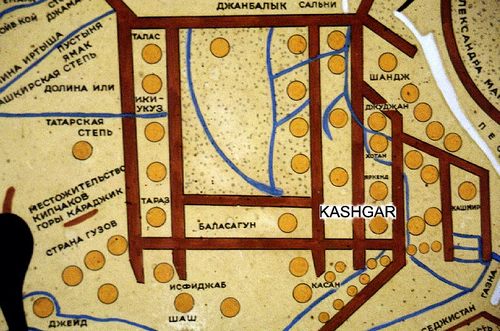
Fig. 2. Kashgar near the center of al-Kashgari’s world. Detail of circular
world map accompanying his Dictionary (reproduction on display in
Ulughbeg Mausoleum, Samarkand).
Today, over sixty percent of Xinjiang’s eighteen million citizens are Muslims, living across an area one-sixth the size of all of China. Under the Chinese Communists, Muslims were divided among ten official nationalities, with the Hui the largest population throughout China, and the Uyghur the largest population in the Xinjiang Uyghur Autonomous Region, established in 1956. According to the reasonably accurate 2000 national census of China, the total Muslim population is 20.3 million, including: Hui (9,816,805); Uyghur (8,399,393); Kazakh (1,250,458); Dongxiang (513,805); Kyrgyz (160,823); Salar (104,503); Tajik (41,028); Uzbek (14,502); Bonan (16,505); Tatar (4,890). This represents about a forty percent population increase over 1990 census figures. The Hui speak mainly Sino-Tibetan languages; Turkic-language speakers include the Uyghur, Kazakh, Kyrgyz, Uzbek, Salar and Tatar; combined Turkic-Mongolian speakers include the Dongxiang and Bonan, concentrated in Gansu’s mountainous Hexi corridor; and the Tajik speak a variety of Indo-Persian dialects. It is important to note, however, that the Chinese census registered people by nationality, not religious affiliation, so the actual number of Muslims is still unknown, and all population figures are clearly influenced by politics in their use and interpretation.
The largest Muslim group in Xinjiang are the Uyghur, numbering nearly nine million, claiming a 1300-year history of descent from the early Uyghur kingdom in Karabalghasan, located in what is now Mongolia, whose kingdom was conquered by Kyrgyz tribesmen in 840 CE. The Uyghur fled southwest and dispersed in the oases towns surrounding the Taklamakan desert where they had maintained trading relations along the ancient Silk Road, establishing Turfan as their newfound capital and Kashgar as one of its most important trading centers. Their far-flung kingdom flourished until the coming of the Mongols in the twelfth century. Prior to the arrival of the Mongols, Islam first arrived in Kashgar by the tenth century CE, and the city became such a center of Islamic learning that one of the greatest Muslim scholars and lexicographers of the eleventh century, Mahmud al-Kashgari, was buried just outside of the city in Upar Village (Fig. 1). Al-Kashgari compiled the first complete Turkish dictionary, which has been translated into 26 languages (Fig. 2). Here, the early Muslims encountered strong Chinese, Persian, Turkic, and Indian influences, much of which can still be seen in the art and architecture of the region.
Islam displaced a multi-religious and multi-cultural tradition that combined elements of Buddhist, Manichaean, Zoroastrian, and even early Nestorian Christian practices (by 650 CE, there was a Nestorian archbishopric in Kashgar), reflecting the importance of the region as a meeting place of many cultures and kingdoms. Early Persian records refer to the southern Tarim region as the home of Kushan tribes, who controlled trade with other Silk Road oases as early as 2000 years ago. The regularity of the caravan trade between the oases of Merv, Balkh, Bukhara, Samarkand, Kashgar, Turpan, and Khotan with the distant European and Asian capitals placed this region in a central role as economic broker and cultural mediator. Hinayana Buddhism flourished in the southern Tarim basin from the second to the tenth centuries CE, when the Chinese monk, Xuanzang (Hsuan-tsang), reported in 644 CE that the oasis city of Kashgar produced a “luxuriance of fruit and flowers.” Xuanzang was impressed not only with the widespread practice of Buddhism, but also the vibrancy of the bazaar and multi-ethnic character of the people, some with “blue eyes” and “yellow hair,” perhaps of Sogdian or East Iranian origin. That diversity is evident to today, where the daily market attracts thousands, and the famous Sunday bazaar (Fig. 3, next page) boasts over ten thousand, including Han Chinese, Uyghur, Russian, Tajik, Kyrgyz, Uzbek, and Kazakh patrons, as well as the ubiquitous foreign tourists.
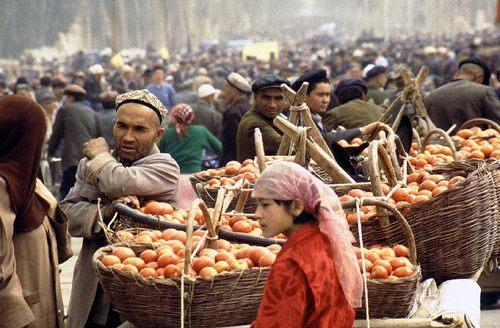
Fig. 3. The Kashgar Sunday bazaar.
As a trading region, southern Xinjiang grew under the Han Chinese General Ban Qiao who campaigned in the region for 31 years in the first century, and remained under nominal Chinese control until the early T’ang dynasty, but succumbed to Tibetan rule between 670 and 694. From the tenth to the twelfth centuries, the Kara-khanid Khanate, an alliance of Karlukh Turkic tribes that had accepted Islam, established their capital in Kashgar, and ruled the surrounding trading centers from Bukhara to Khotan. The Sunni Muslim, Satoq Bughra, who died around 955 CE, is credited with introducing Islam to Xinjiang. A Turk from the clan of the Karakhanids, he was converted to Islam by Nasr b. Mansur of the Samanid family who had been ruling eastern Iran and much of Central Asia and Transoxiana, and was supposedly sent to the Kashgar region on a trade mission, where he eventually became khan. He and his devout successors extended Islamic influence throughout the southern oases, where Buddhism had once boasted 160 monasteries in Khotan alone. On the eastern end of the Tarim basin in places like Hami and perhaps parts of Turfan, Uyghurs continued to practice Buddhism until the sixteenth century. Today, the 162 Sunni mosques in Kashgar alone evidence the enduring presence of Islam, though Buddhist influence can be found in the extraordinarily multi-varied artwork, music, and dance produced by the Uyghur people (Fig. 4). Sufism also gained many followers among the Sunni Muslims, with mostly Central Asian Yasawi and later Naqshbandi tarikats finding followers. Inter-ethnic and religious rivalries increased until the region came under the Mongol rule through Chagatai, the son of Genghis Khan, until Tamerlane’s army was able to reclaim Kashgar for a brief period in the mid-fourteenth century. The Persian historian Ala-ad-Din Ata-Malik Juvaini in his visit to the region during the mid-thirteenth century reported that Mongolian rule was a “divine mercy,” actually felt by local Eastern Turkestani’s to reduce intra-religious factionalism in the region.

Fig. 4. Village mosque on road to Kashgar from the Torugart Pass.
Throughout the period of Mongol rule the region prospered as an important overland trade center in the midst of the peace insured by the Pax Mongolica. It was after this period that Islam continued to flourish, especially in the southern region, with the establishment in Kashgar of the great Idgah Masjid (the Festival Mosque), in 1444, where Muslims still gather in the main square for Qurban and Ramadan holidays. On these days, Uyghurs dance the “sama” in the square, recite the great Uyghur Mukharum epics, and celebrate the unity of Islam in the region. The rise of the Sufi inspired Khojas (from the Persian Khwaja, “master”), and their internecine struggles for power that raged between Kashgar and Yarkand from the sixteenth to the nineteenth centuries, saw political and religious competition for influence over the strategic southern region, and their conflicts only ended with Qing rule under Emperor Qianlong in 1754. Today, many of the tombs of the Khojas can still be visited in the Apak Khoja tomb complex in the north end of Kashgar, built originally in 1640 (Fig. 5).
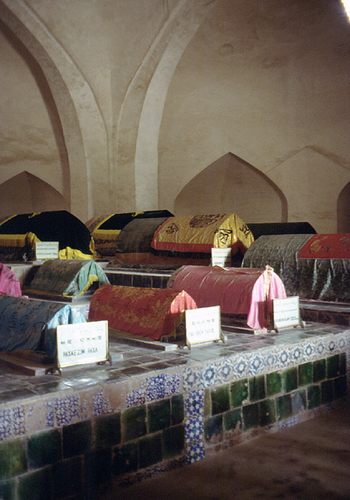
Fig. 5. Interior of Apak Khoja
mausoleum, Kashgar.
Unlike the Chinese Ming dynasty (1368-1644) before them, the Manchu Qing (1644-1911) were more interested in trade with Central and Inner Asia, and the Emperor Qian Long extended Chinese rule through powerful military and economic integration of the region. Chinese rule was disrupted, however, by the rise of the Kashgar ruler, Yakub Beg, who from 1866-1877 established a Uyghur Muslim kingdom in the region. Yakub Beg took advantage of shifting power struggles in the region during the period of the so-called Great Game, when Russian, British, and Chinese empires competed for control over the strategic overland routes that ran through Xinjiang, coming to an end in 1884 when Chinese rule was established and the term “Xinjiang” became widely used for the first time to refer to the entire region as a “new dominion” of Qing imperial control. Until this time, the region was generally referred to as “Eastern Turkestan” or “Chinese Turkestan,” and even “High Tatary” in Owen Lattimore’s words. With the overthrow of the Qing dynasty in 1910, the region was once again a site of intense competition for control, particularly between the expanding Soviet penetration of Central Asia and the attempts of the Chinese Nationalist Kuomin-tang to retain the old Qing boundaries of China, that included Tibet and Xinjiang.
As Kuomintang Chinese rule in Xinjiang eroded during the 1930s and 1940s, several Uyghur-led rebellions broke out. Two “East Turkestan Republics” sought to establish separate Muslim states, both influenced strongly by the threat of the neighboring USSR. Intensive maneuvering enabled the first to survive from 1931 to 1934 and the second from 1944 to 1949. It is tempting to dismiss these abortive states or Yakub Beg’s brief rule in the previous century as mere adventures. But it is clear that Mao Zedong took them seriously, detecting in them the presence of powerful centripetal forces that could seriously undermine Communist rule. Civil war, inter-ethnic conflicts between Hui Chinese Muslims, Uyghur and Han Chinese, despotic nationalist rule under Sheng Shicai, and fear of Russian expansion, led Xinjiang citizens weary of war and civil strife to welcome the “peaceful liberation” of the region by People’s Liberation Army soldiers in 1949. By 1957, Urumqi was a key city in the newly formed Xinjiang Uyghur Autonomous Region, and the PRC government sought to further integrate the region into People’s China through national education, telecommunications, and political development. It is for this reason that Mao Zedong, after his troops “liberated” Xinjiang, agreed upon the legal designation of special governance of the region, under the title “Xinjiang Autonomous Region.” This makes Xinjiang one of five Autonomous Regions in China, including Tibet, Ningxia, Inner Mongolia, and Guangxi (in southern China). It is also significant that Mao’s own brother died during efforts to wrest Xinjiang from Nationalist rule. So for many reasons Xinjiang has always posed an enormous challenge to Chinese rule, whether Communist, Nationalist, or Imperial, providing a legacy fraught with danger, but promising enormous wealth.
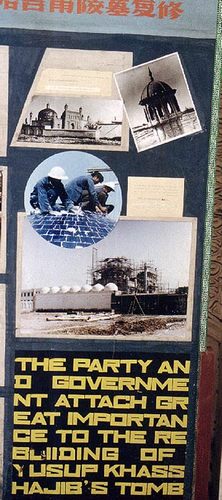
Fig. 6. Official promotion of
“Uyghur” heritage at the
Kashgar tomb of Yusup
Khass Hajib, the 11th
century “father” of Turkic
Islamic literature.
China’s integrationist and educational policies since 1949 have enormously expanded the ranks of the Turkic urban intelligentsia in Xinjiang. Turkic, mainly Uyghur and Kazakh, intellectuals advanced in many fields but also encountered impediments as well. Whether or not they considered themselves Uyghur prior to their encounters with the Han Chinese establishment in Xinjiang, many came to think of themselves as Uyghur afterwards. By such a process that directly recalls what took place earlier in the Soviet republics of Central Asia, the ethnic and national policies of a Communist state fostered the development, if not the creation, of new ethnic national consciousnesses (Fig. 6). In Xinjiang, as well as other minority areas of China, official minority nationalities receive special benefits, such as exemption from the one-child birth program (minorities are generally allowed two or three children, and in very poor areas, even more), special scholarships to secondary and higher educational institutions, tax relief, and bi-lingual education schools that teach in the local minority languages up through university. In addition, minority government officials are actively recruited in order to promote a sense of participation in governance. Nevertheless, the Chinese Communist Party, which has many fewer minorities and is generally the final authority in areas of governance, continues to exercise the greatest power in the region.
In addition, one cannot minimize the role of improved communications and transportation in the creation of a region-wide consciousness among Xinjiang’s Turkic peoples. The ability to travel easily by truck, bus, or railroad enables people of modest means to form contacts with Turkic speakers hundreds of miles from home. Radio and television broadcasts in the Uyghur language and improved telephone connections also facilitate interaction over distances. Taken together, these very different developments have fueled an unprecedented growth of national consciousness among the Uyghur Turks of Xinjiang, which in turn gives rise to a nationalist force that is different in kind and strength from any that had existed in the past.
The social base of this new consciousness does not correspond precisely to the borders of Xinjiang. The northern Kazakhs remain somewhat disengaged, perhaps because of their own rivalries with the Uyghur and the rise of an independent Kazakhstan, and most of the other large ethnic groups, such as the Hui, Kyrgyz, and Xinjiang Han, see their best chances in cooperating with Chinese rule rather than objecting to it. Traditional divides between traditionally agrarian and urban Muslim populations (Uyghur and Hui), and the formerly nomadic Muslim populations (Kazakh and Kyrgyz), continue to this day. Not unlike Western American rivalries between ranchers and farmers, the agrarian Uyghur and Hui are concentrated in the oases and towns, whereas the Kazakh and Kyrgyz are based in the higher-elevation mountainous regions of the Pamir, Tianshan, and Altai ranges. Although the majority of the Kazakh and Kyrygz no longer derive their primary incomes from herding, there are still nearly thirty percent of their populations who are registered as “pastoralists” (mu min), and maintain a fairly nomadic lifestyle, moving their entire families with their mixed herds (sheep, cattle, camels, horses, and even yaks) from the summer pastures in the higher elevation to the winter pastures along the lower-elevation steppe zones. This nomadic pastoralist lifestyle was severely curtailed during the more radical Maoist periods of the 1960s and 1970s, but under the Deng Xiaoping reform era, began to return in a vibrant fashion. Under the market economy, pastoral products have increased in demand to the extent in many areas, herd sizes have increased beyond the natural carrying capacity of the grasslands. The government has attempted to resolve this conflict through sedentarization policies that have had mixed results. In addition, traditional competition for scarce resources (farmland versus grazing land) has led to ethnic conflict between pastoralists (Kazakh and Kyrgyz) and farmers (mainly Uyghur, Han, and Hui).
Beijing has based its approach to regional governance on principles of standardization, centralization and assimilation. Given this, it was probably inevitable that this some Uyghurs who had hoped for greater autonomy would clash with policies of the Peoples’ Republic of China in many areas. Many Uyghurs, especially younger urban males, have reacted to Beijing’s “top down” style of rule with covert and overt shows of resistance. Some support ecological causes, greater religious freedoms, native language training, programs to prevent and treat AIDS, or even anti-alcohol campaigns, and yet others actively engage in illegal activities, such as drug-smuggling and acts of violence. As a result, perhaps of China’s more “open door” policy of Deng Xiaoping and his successors, the level of civil unrest increased dramatically during the 1990s. Chinese government sources enumerate almost daily incidents of violence, and Amnesty International released a series of reports condemning China’s harsh treatment of those accused of separatism. Particularly bloody confrontations occurred at the town of Baren in 1990 and in Yining in 1997. The government was quick to blame these outbreaks on separatists (called “splittists”), Muslim radicals, or terrorists, and designed its indelicately named “Strike Hard! Maximum Pressure!” campaign explicitly to counter them. The “Strike Hard” campaign officially ended in 2004, and there have not been any violent clashes in the region since the late 1990s. Nevertheless, the government has continued to restrict public gatherings and any activities, religious or otherwise, that might be regarded as supporting separatism.
In a rather post-modern twist along the ancient Silk Road, China’s so-called “war on terrorism” has been increasingly waged against a group of non-state actors, primarily living outside of China for at least two to three generations, largely organized through the Internet (in what I have termed cyber-separatism), for whom radical Islam has only recently begin to grow in appeal. Interestingly, this diasporic ethnoreligious identity has helped land 22 of them in the interrogation/detention cells at Guantánamo Bay, Cuba, caught up in the net of those accused of fighting for the Taliban and al-Qaida in Afghanistan. Not unlike Tibet, a place that has also seen religiously-motivated terrorism against the Chinese state, their rationale for violence can only be understood as ethnoreligious, combining land with liberation from a nation-state system that has wrested their religious homeland away from them, which they refer to as Eastern Turkestan or even Uyghuristan, but which the Chinese state has referred to as “Xinjiang” (or “New Territory”) only since 1884. We must recall that the region has always been caught between great power politics. In an effort to prevent the further expansion of the Russian tsarist empire across Central Asia, the Chinese emperor sent troops to finally incorporate the region into China proper, delineating a border with Russia near Ili (today’s Yining or Ghulja in Uyghur), in what the late Joseph Fletcher once called China’s “First Treaty Port.” Today, most travelers to the region report almost no evidence of civil unrest and attest to the fact that it is one of the safest places to travel in all of Central Asia, perhaps due to the strong presence of Chinese police in the region.
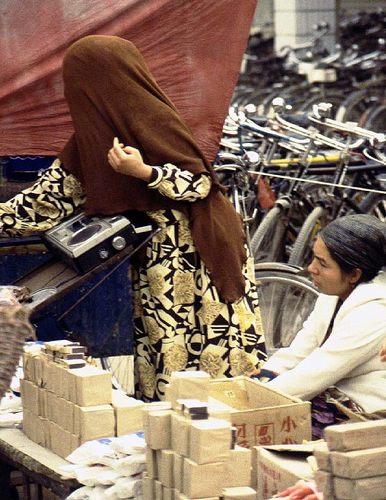
Fig. 7. Islam and modernity in the
Kashgar bazaar.
The seventh-century Buddhist monk Xuanzang’s comment still rings true today: the oasis cities, including Hami, Turpan, Aksu, Kashgar, and Hotan, continue to be green centers for fruit, vegetable, rice, wheat, bean, and cotton production. Vast energy and mineral resources have contributed to the region’s importance to China’s modernization goals. As an important part of China’s “Great Western Development” campaign, launched in 2001, the main challenge will be to maintain a cultural and religious continuity with the vibrant institutions and traditions that have made Xinjiang a diverse and welcoming stopping place for the weary traveler on the new Silk Road. The goals of the Great Western Development campaign have been to help the poorer Western regions “catch-up” with the more developed eastern and coastal regions, which received greater central government support during Deng Xiaoping’s “get rich quick” campaigns. Under former President Jiang Zemin, the western regions, particularly Xinjiang, Qinghai, Gansu, Tibet, Inner Mongolia, Sichuan, and Yunnan were targeted for greater infrastructural and communications investment, to the extent that vast road, rail, and telecommunications projects have been initiated. President Hu Jintao has continued with this program, but the huge gaps in income and social welfare between the west and southeast remain. Despite its “Freedom of Religion” policy which is enshrined in China’s constitution and cultural preservation programs that have sought to preserve minority culture, language, and material history through giving special privileges to minorities (including exemption from the one-child birth-planning policy, educational opportunities, and tax relief), the real threat to local Muslim culture may come more from modernization than from Chinese assimilation or migration (Fig. 7). Yet, increasing Han Chinese migration to the region reflects a 2000-year history of cross-cultural trade and movement, and greater opportunities in the region have attracted a growing number of poorer Han Chinese from the inland regions, as well as skilled laborers and technicians that often displace the local population from gainful employment. Conversely, better-skilled Uyghur from urban areas with university educations are often attracted to the urban centers of China where they have more opportunities than in their homeland, or increasingly seek opportunities abroad where they feel they have a better chance at advancement than in Urumqi. This brain drain often divests the region from cultivating its own native elite. At the same time, developing cross-border trade with the new Central Asian states and growing international tourism has once again opened the region to an array of multinational influences. One can only hope that Uyghur and other local cultures will continue to flourish and develop in this new period of globalization.
About the Author
Dru Gladney is Professor of Asian Studies and Anthropology at the University of Hawaii at Manoa. Among his many publications on ethnic and cultural nationalism are Muslim Chinese: Ethnic Nationalism in the People’s Republic (Harvard University Press, 1991) and Dislocating China: Muslims, Minorities, and Other Subaltern Subjects (University of Chicago Press, 2004). He is currently finishing a book-length study entitled Nomadology: Borderline Identities and Peripheral Perspectives. He may be contacted at dru@hawaii.edu.
References
- Samuel Beal, trans. Buddhist Records of the Western World (London: Trubner, 1884).
- Owen Lattimore. High Tartary. Boston: Little, Brown, 1930.
- Mahmud al-Kashgari. Divanü Lugat-it-Türk. Tr. Robert Dankoff and James Kelly. 3 vols. Cambridge, Mass.: 1982-1985.
- Aurel Stein. On Ancient Central-Asian Tracks. Chicago and London: University of Chicago Press, 1974.
